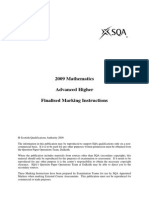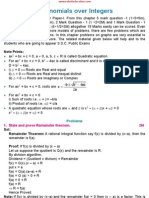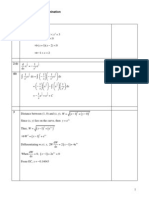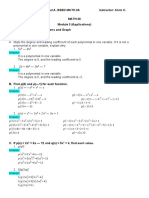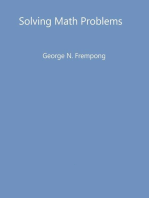2010 Maths Advanced Higher Finalised Marking Instructions
2010 Maths Advanced Higher Finalised Marking Instructions
Uploaded by
QwaAlmanlawiCopyright:
Available Formats
2010 Maths Advanced Higher Finalised Marking Instructions
2010 Maths Advanced Higher Finalised Marking Instructions
Uploaded by
QwaAlmanlawiOriginal Title
Copyright
Available Formats
Share this document
Did you find this document useful?
Is this content inappropriate?
Copyright:
Available Formats
2010 Maths Advanced Higher Finalised Marking Instructions
2010 Maths Advanced Higher Finalised Marking Instructions
Uploaded by
QwaAlmanlawiCopyright:
Available Formats
2010 Maths
Advanced Higher
Finalised Marking Instructions
Scottish Qualifications Authority 2010
The information in this publication may be reproduced to support SQA qualifications only on a noncommercial basis. If it is to be used for any other purposes written permission must be obtained from
the External Print Team, Centre Services, Dalkeith.
Where the publication includes materials from sources other than SQA (secondary copyright), this
material should only be reproduced for the purposes of examination or assessment. If it needs to be
reproduced for any other purpose it is the centres responsibility to obtain the necessary copyright
clearance. SQAs External Print Team, Centre Services, at Dalkeith may be able to direct you to the
secondary sources.
These Marking Instructions have been prepared by Examination Teams for use by SQA Appointed
Markers when marking External Course Assessments. This publication must not be reproduced for
commercial or trade purposes.
General Marking Principles
These principles describe the approach taken when marking Advanced Higher Mathematics papers. For
more detailed guidance please refer to the detailed Marking Instructions.
1
The main principle is to give credit for the skills demonstrated and the criteria met. Failure to have
a correct method may not preclude a candidate gaining credit for their solution.
The answer to one part of a question, even if incorrect, can be accepted as a basis for subsequent
dependent parts of the question.
The following are not penalised:
working subsequent to a correct answer (unless it provides firm evidence that the requirements
of the question have not been met)
legitimate variation in numerical values / algebraic expressions.
Full credit will only be given where the solution contains appropriate working. Where the correct
answer might be obtained by inspection or mentally, credit may be given.
Sometimes the method to be used in a particular question is explicitly stated; no credit will be
given where a candidate obtains the correct answer by an alternative method.
Where the method to be used in a particular question is not explicitly stated in the question paper,
full credit is available for an alternative valid method. (Some likely alternatives are included but
these should not be assumed to be the only acceptable ones.)
In the detailed Marking Instructions which follow, marks are shown alongside the line for which they are
awarded. There is one code used M. This indicates a method mark, so in question 1(a), 1M means a
method mark for the product rule.
Advanced Higher Mathematics 2010
Marks awarded for
1.
(6)
(a) For f (x) = ex sin x2,
f (x) = ex sin x2 + ex (2x cos x2) .
1M using the Product Rule
1,1 one for each correct term
(b) Method 1
x3
,
(1 + tan x)
3x2 (1 + tanx) x3 sec 2 x
g(x) =
.
(1 + tanx)2
For g (x) =
1M using the Quotient Rule
1
1
first term and denominator
second term
for correct rewrite
Method 2
g (x) = x3 (1 + tan x)1
g (x) =
3x2 (1 + tanx)1 + x3 (1) (1 + tanx)2 sec 2 x 1,1
=
2.
(5)
x2
(1 + tan x)2
(3
for accuracy
+ 3 tan x x sec 2 x)
Let the first term be a and the common ratio be
r. Then
ar = 6
and
ar2 = 3
1
Hence
ar2
3
1
r =
=
= .
1
ar
6
2
So, since |r| < 1, the sum to infinity exists.
1
a
1
S =
1 r
12
12
=
= 3
1
1 ( 2 )
2
1
= 8.
{both terms needed}
evaluating r
justification
correct formula
the sum to infinity
Marks awarded for
3.
(7)
t = x4 dt = 4x3dx
(a)
x3
1
4x3
dx
=
dx
1 + x8
4 1 + (x4)2
1
1
=
dt
4 1 + t2
= 14 tan1 t + c
=
(b)
tan1 x4 + c
1
4
x2 ln x dx = (ln x) x2dx
= ln x x2dx 1x x3 dx
3
1 3
3x
1 3
3x
4.
(4)
ln x
ln x
1
2
3 x dx
1 3
9x + c
( )
2 0
gives an enlargement,
0 2
scale factor 2.
The matrix
The matrix
( )
( )(
3
2
1
2
gives a clockwise
23 12
rotation of 60 about the origin.
1
2
M =
=
5.
(4)
3
2
3
2
1
2
2 0
0 2
3
.
3 1
( ) ()
(n + 1)!
n!
n
n+1
3
3
3!(n 2)! 3!(n 3)!
(n + 1)!
n!(n 2)
=
3!(n 2)! 3!(n 2)!
(n + 1)! n!(n 2)
=
3!(n 2)!
n! [ (n + 1) (n 2)]
=
3! (n 2)!
n! 3
n!
=
=
3!(n 2)! 2!(n 2)!
=
()
n
2
correct differential
correct integral in t
correct answer
1M for using integration by parts
1 for differentiating ln x
1,1
correct matrix
correct matrix
correct order
both terms correct
{alternative methods
will appear}
1
1
correct numerator
correct denominator
1
1 for knowing (anywhere)
(n 2)! = (n 2) (n 3)!
Marks awarded for
6.
(4)
v w =
= i
=
u. (v w) =
=
=
7.
(6)
i j k
3 2 1
1 1 4
1M a valid approach
| 21 14 | j| 13 14 | + k | 13 21 |
9i 11j + 5k
(2i + 0j + 5k) . (9i 11j + 5k)
18 + 0 + 25
7.
5
1 (x + 1)(x3x++2)(x
+ 3) dx
3x + 5
(x + 1)(x + 2)(x + 3)
A
x+1
B
x+2
C
x+3
1M
3x + 5 =
A(x + 2)(x + 3) + B(x + 1)(x + 3) + C(x + 1)(x + 2)
x = 1 2 = 2A A = 1
x = 2 1 = B B = 1
x = 3 4 = 2C C = 2
1
1
Hence
3x + 5
1
1
2
=
+
(x + 1)(x + 2)(x + 3) x + 1 x + 2 x + 3
for first correct coefficient
for second correct coefficient
for last coefficient and
applying them
5
1
1
2
1 (x + 1)(x3x++2)(x
+ 3) dx = 1 ( x + 1 + x + 2 x + 3 ) dx
2
= [ ln (x + 1) + ln (x + 2) 2 ln (x + 3)] 21 1
= ln3 + ln4 2 ln5 ln2 ln3 + 2 ln4
3 4 42
32
= ln 2
= ln
1
5 2 3
25
8.
(6)
(a) Write the odd integers as: 2n + 1
and 2m + 1 where n and m are integers.
Then
(2n + 1)(2m + 1) = 4nm + 2n + 2m + 1
= 2(2nm + n + m) + 1
which is odd.
(b) Let n = 1, p1 = p which is given as odd.
Assume pk is odd and consider pk + 1.
pk + 1 = pk p
Since pk is assumed to be odd and p is
odd, pk + 1 is the product of two odd
integers is therefore odd.
Thus pn + 1 is an odd integer for
all n if p is an odd integer.
for correct integration and
substitution
1M for unconnected odd integers
demonstrating clearly
1
1M
1
for a valid explanation from a
previous correct argument
Marks awarded for
9.
(4)
Let f (x) = (1 + sin 2 x). Then
f (x)
=
=
f (x) =
f (x) =
f (x) =
2 sin x cos x
sin 2x
2 cos 2x
4 sin 2x
8 cos 2x
f (0) = 1
f (0) = 0
f (0) = 2
f (0) = 0
f (0) = 8
x2
x4
8 +
2!
4!
1
= 1 + x2 x4 +
3
f (x) = 1 + 2
1
1
one for each non-zero term
Alternative 1
f (0) = 1 1
f (0) = 0
f (0) = 2 1
f (0) = 0
f (x)
= 2 sin x cos x
f (x) = 2 cos2 x 2 sin 2 x
f (x) = 4( sin x) cosx
4 cos x sin x
f (x) = 8 cos2 x + 8 sin 2 x f (0) = 8 1
etc
Alternative 2
f (x) = (1 + sin 2 x)
= 1 + 12 12 cos 2x
=
1
2
1
2
1
2
(3 cos 2x)
(3
(2x)2
2!
(3 1 + 2x
= 1 +
10.
(3)
(1
x2
1 4
3x
(2x)4
4!
2 4
3 x
The graph is not symmetrical about the
y-axis (or f (x) f (x))
so it is not an even function.
The graph does not have half-turn
rotational symmetry (or f (x) f (x))
so it is not an odd function.
The function is neither even nor odd.
))
introducing cos2x
1
1
1
expanding cos2x
simplifying
finishing
1
1
{apply follow through}
Marks awarded for
11.
(7)
d 2y
dy
+ 4
+ 5y = 0
2
dx
dx
m2 + 4m + 5 = 0
(m + 2)2 = 1
m = 2 i
The general solution is
y = e2x (A cos x + B sin x)
x = 0, y = 3 3 = A
x = 2 , y = e e = e (3 cos 2 + B sin 2 )
B=1
Assume 2 + x is rational
p
and let 2 + x = where p, q are integers.
q
1M appropriate CF
for accuracy
1
1
p
2
q
p 2q
=
q
Since p 2q and q are integers, it follows
that x is rational. This is a contradiction.
1
1
1
x =
So
13.
(10)
The particular solution is:
y = e2x (3 cosx + sin x).
12.
(4)
y = t 3 25 t 2
x =
t = t 1/2
dy
dt
dx
dt
= 3t 2 5t
=
1 1/2
2t
dy
3t 2 5t
=
1 1/2
dx
2t
= 6t 5/2 10t 3/2
d 2y
=
dx2
( )
d dy
dt dx
dx
dt
as a single fraction
1
1
1
1
1
for eliminating fractions
1M
6 25 t 3/2 10 23 t 1/2
1 1/2
2t
= 30t 2 30t
i.e. a = 30, b = 30
d y
At a point of inflexion, dx
2 = 0 t = 0 or 1
dy
But t > 0 t = 1 dx
= 4
1
3
and the point of contact is (1, 2 )
1
Hence the tangent is
y + 23 = 4 (x 1)
i.e. 2y + 8x = 5
the value of the gradient
Marks awarded for
14.
(10)
1 1 1
1 1 2
2 1 a
1
0
2
1 1
1
0 2
1
0 1 a 2
1
1
0
1 1
1
0 2
1
0 0 2a 5
1
1
1
for triangular form
one correct variable
for the two other variables
{other justifications for
uniqueness are possible}
z =
2y +
1
;
2a 5
for a structured approach
1
2a + 5 1
= 1 2y =
2a 5
2a 5
2 a
y =
;
2a 5
2a
1
+
=1
2a 5 2a 5
2a 5 1 a
a4
x=
+
=
.
2a 5 2a 5 2a 5
x
which exist when 2a 5 0.
From the third row of the final tableau,
when a = 25, there are no solutions
When a = 3, x = 1, y = 1, z = 1.
)( ) ( )
( ) ()
5 2 3 1
1
AB = 1 1 1 0 = 1
1
3 1 2 2
1
1
From above, we have C 1 = 0 and
1
2
1
1
also A 0 = 1 which suggests AC = I and
1
2
this can be verified directly. Hence
A is the inverse of C (or vice versa).
() ( )
A candidate who obtains
AC = I directly may be
awarded full marks.
Marks awarded for
(x ) = 8x x4 = 8x x = 0, 2
2 2
15.
Area = 4 0 ( 8x x2) dx
2
values of x
1M 4 20
1
the rest
( )
2
1 2
= 4 8 x3/2 x3
3
3 0
16
8
32
= 4
=
3
3
3
1
1
Volume of revolution about the y-axis = x2dy. 1M
So in this case, we need to calculate
two volumes and subtract:
V = [ 0 y dy] [ 0
4
4 y4
64 dy
y5 4
y2 4
=
2 0
320 0
64 42
= 8
320
40 16
24
( 15)
=
=
5
5
16.
(10)
1,1
each term
z3 = r3 (cos 3 + i sin 3 )
(cos 23 + i sin 23 )3 = cos 2 + i sin 2
a = 1; b = 0
necessary
Method 1
r3 (cos 3 + i sin 3 ) = 8
r3 cos 3 = 8 and r3 sin 3 = 0
r = 2; 3 = 0, 2, 4
Roots are 2, 2 (cos 23 + i sin 23 ), 2 (cos 43 + i sin 43 ).
In cartesian form: 2, (1 + i 3) , (1 i 3)
Method 2
z3 8 = 0
(z 2) (z2 + 2z + 4) = 0
(z 2) ((z + 1)2 + ( 3)2) = 0
so the roots are: 2, (1 + i 3) , (1 i 3)
(a)
z1 + z2 + z3 = 0
(b) Since z31 = z32 = z33 = 8
it follows that
z61 + z62 + z63 = (z31)2 + (z32)2 + (z33)2
= 3 64 = 192
1
1
1
1
1
1
1
1
1
1
END OF SOLUTIONS
or by using quadratic formula
You might also like
- Rvhs h2 Math p1 SolutionsDocument13 pagesRvhs h2 Math p1 SolutionsjimmytanlimlongNo ratings yet
- Problem 1: Markov Reward ProcessDocument3 pagesProblem 1: Markov Reward ProcessAbdul TaufeeqNo ratings yet
- 2011 Maths Advanced Higher Finalised Marking InstructionsDocument12 pages2011 Maths Advanced Higher Finalised Marking InstructionsCisum ErupNo ratings yet
- Mi AH Mathematics All 2011Document12 pagesMi AH Mathematics All 2011QwaAlmanlawiNo ratings yet
- Mi AH Mathematics All 2012Document11 pagesMi AH Mathematics All 2012QwaAlmanlawiNo ratings yet
- 2007 Mathematics Advanced Higher Finalised Marking InstructionsDocument9 pages2007 Mathematics Advanced Higher Finalised Marking InstructionsQwaAlmanlawiNo ratings yet
- 2009 Mathematics Advanced Higher Finalised Marking InstructionsDocument10 pages2009 Mathematics Advanced Higher Finalised Marking InstructionsQwaAlmanlawiNo ratings yet
- Section G: Integer Answer Type: X FX F XDocument10 pagesSection G: Integer Answer Type: X FX F XsatwiksmNo ratings yet
- Engineering MathsDocument8 pagesEngineering MathsSanthosh SanNo ratings yet
- Mathematics Sample Paper Solutions Section-ADocument19 pagesMathematics Sample Paper Solutions Section-APoonamBhardwajNo ratings yet
- HCI 2008 Promo W SolutionDocument12 pagesHCI 2008 Promo W SolutionMichael CheeNo ratings yet
- IIT 2012 12 13 p1 p2 Mat UN4 SADocument66 pagesIIT 2012 12 13 p1 p2 Mat UN4 SAAnkit RaiNo ratings yet
- Mathematics TDocument62 pagesMathematics TRosdy Dyingdemon100% (1)
- RT Solutions-Practice Test Papers XIII VXY 1 To 6 SolDocument40 pagesRT Solutions-Practice Test Papers XIII VXY 1 To 6 Solvishal110085No ratings yet
- Answers Are You Ready For CalculusDocument6 pagesAnswers Are You Ready For CalculusKevin HsiehNo ratings yet
- Polynomials Over Integers: Note PrintsDocument14 pagesPolynomials Over Integers: Note PrintsKomanduri Murali SrinivasNo ratings yet
- 102 2013 1 BDocument20 pages102 2013 1 BmatshonaNo ratings yet
- Analytical Geometry: y y M X XDocument10 pagesAnalytical Geometry: y y M X XKomanduri Murali SrinivasNo ratings yet
- Maths c4 June 2012 Mark SchemeDocument14 pagesMaths c4 June 2012 Mark SchemeAditya NagrechàNo ratings yet
- Mark Scheme (Results) January 2010: Core Mathematics C3 (6665)Document12 pagesMark Scheme (Results) January 2010: Core Mathematics C3 (6665)Taqsim RajonNo ratings yet
- MA1521 Solution3Document5 pagesMA1521 Solution3Ray TanNo ratings yet
- JC2 Prelim H2 Math Solution Paper 1Document10 pagesJC2 Prelim H2 Math Solution Paper 1Huixin LimNo ratings yet
- 2024S2MAT512AD AssignmentDocument15 pages2024S2MAT512AD AssignmentValentinoNo ratings yet
- IB Diploma Programe Standard Level Course Companion Worked Solution Chapter 1Document13 pagesIB Diploma Programe Standard Level Course Companion Worked Solution Chapter 1DeeganasNo ratings yet
- c4 Jan 2008 MsDocument21 pagesc4 Jan 2008 MsMk D. AssassinoNo ratings yet
- Maths Formula SheetDocument2 pagesMaths Formula SheetYedu T DharanNo ratings yet
- Math Quest Math Methods VCE 12 (2016 Edition)Document542 pagesMath Quest Math Methods VCE 12 (2016 Edition)NhiNo ratings yet
- Seafield 2013 M1 (Q&A)Document8 pagesSeafield 2013 M1 (Q&A)STPMmathsNo ratings yet
- Ath em Ati CS: L.K .SH Arm ADocument8 pagesAth em Ati CS: L.K .SH Arm APremNo ratings yet
- Aieee 2012 Paper 1Document32 pagesAieee 2012 Paper 1Ravi LorventNo ratings yet
- RT Solutions-22!01!2012 XIII VXY Paper II Code A SolDocument16 pagesRT Solutions-22!01!2012 XIII VXY Paper II Code A Solvishal110085No ratings yet
- Ath em Ati CS: L.K .SH Arm ADocument9 pagesAth em Ati CS: L.K .SH Arm APremNo ratings yet
- 12th Maths Exam Paper (2008-2012) FinalDocument430 pages12th Maths Exam Paper (2008-2012) FinalAdityas AravindNo ratings yet
- One Mark For Each Intercept Down Ward.: A A X yDocument14 pagesOne Mark For Each Intercept Down Ward.: A A X yKarabo MailulaNo ratings yet
- Chapter 8 FWSDocument32 pagesChapter 8 FWSChan KarlokNo ratings yet
- Mcv4ub Unit2 Parul MarkedDocument21 pagesMcv4ub Unit2 Parul MarkedKaran RaghuvanshiNo ratings yet
- MATH26 M4 Applications Manguilimotan BSEDMath3ADocument11 pagesMATH26 M4 Applications Manguilimotan BSEDMath3ARetchel ManguilimotanNo ratings yet
- Pure Mathematics: For CAPEDocument11 pagesPure Mathematics: For CAPERonaldoNo ratings yet
- Jee Main Model Questions: MathematicsDocument2 pagesJee Main Model Questions: MathematicsVijayabhaskarareddy VemireddyNo ratings yet
- c4 Jan 2009 MsDocument25 pagesc4 Jan 2009 MsMk D. AssassinoNo ratings yet
- 2014 2 JOHOR SMK Dato Jaafar JohorBahru MATHS ADocument3 pages2014 2 JOHOR SMK Dato Jaafar JohorBahru MATHS ASKNo ratings yet
- Muller's Method: Numerical Analysis - MTH603Document7 pagesMuller's Method: Numerical Analysis - MTH603Sandesh AhirNo ratings yet
- Mathematics Alternative A AnswersDocument5 pagesMathematics Alternative A Answersmoggadavid480No ratings yet
- Leep 214Document23 pagesLeep 214Koyal Gupta100% (1)
- AQA C1 Revision NotesDocument8 pagesAQA C1 Revision NotesLscribd15No ratings yet
- 2012 ACJC Prelim H2 Math SolnDocument15 pages2012 ACJC Prelim H2 Math Solnckhowh_23284524667% (3)
- 2014 2 JOHOR SMKTinggiKluang Maths QADocument8 pages2014 2 JOHOR SMKTinggiKluang Maths QASK100% (2)
- Application of Derivatives Tangents and Normals (Calculus) Mathematics E-Book For Public ExamsFrom EverandApplication of Derivatives Tangents and Normals (Calculus) Mathematics E-Book For Public ExamsRating: 5 out of 5 stars5/5 (1)
- Trigonometric Ratios to Transformations (Trigonometry) Mathematics E-Book For Public ExamsFrom EverandTrigonometric Ratios to Transformations (Trigonometry) Mathematics E-Book For Public ExamsRating: 5 out of 5 stars5/5 (1)
- Analytic Geometry: Graphic Solutions Using Matlab LanguageFrom EverandAnalytic Geometry: Graphic Solutions Using Matlab LanguageNo ratings yet
- Inverse Trigonometric Functions (Trigonometry) Mathematics Question BankFrom EverandInverse Trigonometric Functions (Trigonometry) Mathematics Question BankNo ratings yet
- Differentiation (Calculus) Mathematics Question BankFrom EverandDifferentiation (Calculus) Mathematics Question BankRating: 4 out of 5 stars4/5 (1)
- Mathematics 1St First Order Linear Differential Equations 2Nd Second Order Linear Differential Equations Laplace Fourier Bessel MathematicsFrom EverandMathematics 1St First Order Linear Differential Equations 2Nd Second Order Linear Differential Equations Laplace Fourier Bessel MathematicsNo ratings yet
- Factoring and Algebra - A Selection of Classic Mathematical Articles Containing Examples and Exercises on the Subject of Algebra (Mathematics Series)From EverandFactoring and Algebra - A Selection of Classic Mathematical Articles Containing Examples and Exercises on the Subject of Algebra (Mathematics Series)No ratings yet
- De Moiver's Theorem (Trigonometry) Mathematics Question BankFrom EverandDe Moiver's Theorem (Trigonometry) Mathematics Question BankNo ratings yet
- Transformation of Axes (Geometry) Mathematics Question BankFrom EverandTransformation of Axes (Geometry) Mathematics Question BankRating: 3 out of 5 stars3/5 (1)
- Perth Academy: Mathematics Advanced Higher 2005Document4 pagesPerth Academy: Mathematics Advanced Higher 2005QwaAlmanlawiNo ratings yet
- Lim 2Document1 pageLim 2QwaAlmanlawiNo ratings yet
- Lim 1Document1 pageLim 1QwaAlmanlawiNo ratings yet
- AH 2005 Brief AnswersDocument4 pagesAH 2005 Brief AnswersQwaAlmanlawiNo ratings yet
- Higher Homework 3 - Recurrance RelationsDocument2 pagesHigher Homework 3 - Recurrance RelationsQwaAlmanlawiNo ratings yet
- Higher Homework 3 - Straight LineDocument1 pageHigher Homework 3 - Straight LineQwaAlmanlawiNo ratings yet
- Higher Homework 3 - Sets and FunctionsDocument2 pagesHigher Homework 3 - Sets and FunctionsQwaAlmanlawiNo ratings yet
- Higher Maths MC Unit 1 Functions and GraphsDocument3 pagesHigher Maths MC Unit 1 Functions and GraphsQwaAlmanlawiNo ratings yet
- Int 1 Unit 1 Homework - MoneyDocument1 pageInt 1 Unit 1 Homework - MoneyQwaAlmanlawiNo ratings yet
- HSN Course SummaryDocument26 pagesHSN Course SummaryQwaAlmanlawiNo ratings yet
- Higher Maths MC Unit 1 RevisionDocument7 pagesHigher Maths MC Unit 1 RevisionQwaAlmanlawiNo ratings yet
- Higher Maths MC Unit 1 Straight LineDocument9 pagesHigher Maths MC Unit 1 Straight LineQwaAlmanlawiNo ratings yet
- Higher Maths MC Unit 1 DifferentiationDocument10 pagesHigher Maths MC Unit 1 DifferentiationQwaAlmanlawiNo ratings yet
- Section 1.5:: Inverse FunctionsDocument19 pagesSection 1.5:: Inverse FunctionsQwaAlmanlawiNo ratings yet
- 3 EsDocument8 pages3 EsNur Hidayah HoodNo ratings yet
- QB 2014 Math SL 5Document119 pagesQB 2014 Math SL 5Nicole PuyoNo ratings yet
- Lecture 4 - DSO 547 Linear Programming - DasguptaDocument47 pagesLecture 4 - DSO 547 Linear Programming - DasguptaZhaohong WangNo ratings yet
- Certificate: An AnDocument3 pagesCertificate: An AnArmağan DemirelNo ratings yet
- Higher 2 Mathematics: Paper 1Document6 pagesHigher 2 Mathematics: Paper 1Seng SoonNo ratings yet
- MAT 120 NSU SyllabusDocument5 pagesMAT 120 NSU SyllabusChowdhury_Irad_2937100% (1)
- Data Analysis and Interpretation: IpdetDocument55 pagesData Analysis and Interpretation: IpdetJaved KhanNo ratings yet
- Entropy and The UniverseDocument33 pagesEntropy and The UniverselykaonasNo ratings yet
- Pert & CPMDocument22 pagesPert & CPMjonNo ratings yet
- TitrimetryDocument16 pagesTitrimetryDrVikas100% (1)
- Uka MExer03Document14 pagesUka MExer03johannie ukaNo ratings yet
- Data Analysis ProblemsDocument12 pagesData Analysis Problems陈凯华No ratings yet
- Duration: Three Hours Maximum Marks:100: Ma:MathematicsDocument14 pagesDuration: Three Hours Maximum Marks:100: Ma:MathematicsNikhilSharmaNo ratings yet
- Smoothed Finite Element Methods (S-FEM) : An Overview and Recent DevelopmentsDocument39 pagesSmoothed Finite Element Methods (S-FEM) : An Overview and Recent DevelopmentsDebasisMohapatraNo ratings yet
- UECM1693/UECM2623/UGCM2623 Tutorial N3: Solution of Linear SystemsDocument2 pagesUECM1693/UECM2623/UGCM2623 Tutorial N3: Solution of Linear SystemsfreeloadNo ratings yet
- Introduction To Econometrics and Operations ResearchDocument28 pagesIntroduction To Econometrics and Operations ResearchkhongaybytNo ratings yet
- Chap4 - Functions, Pigeonhole PrincipleDocument31 pagesChap4 - Functions, Pigeonhole PrincipleDorian GreyNo ratings yet
- Mae 456 Finite Element Analysis EXAM 1 Practice Questions NameDocument13 pagesMae 456 Finite Element Analysis EXAM 1 Practice Questions Namechellamv100% (1)
- Ma6451 PRP Notes Rejinpaul PDFDocument228 pagesMa6451 PRP Notes Rejinpaul PDFmohanNo ratings yet
- Gauss-Seidel Method: DescriptionDocument4 pagesGauss-Seidel Method: Descriptionدنيا قيس كاظمNo ratings yet
- Measurement of Variables (2016)Document59 pagesMeasurement of Variables (2016)A. Saeed Khawaja100% (1)
- Tracing The Trajectory of Vocational Education Research On Career Adaptability: A Bibliometric StudyDocument14 pagesTracing The Trajectory of Vocational Education Research On Career Adaptability: A Bibliometric StudyJournal of Education and LearningNo ratings yet
- Mathematics Rank Booster CourseDocument2 pagesMathematics Rank Booster CourseabhayNo ratings yet
- 11.3.1 Some Special CasesDocument10 pages11.3.1 Some Special CasesSiddharth KishanNo ratings yet
- Adobe Scan Sep 21 2022Document7 pagesAdobe Scan Sep 21 2022John Rey BalansagNo ratings yet
- 05.01 Newton Raphson MethodDocument30 pages05.01 Newton Raphson MethodJet GamezNo ratings yet
- DECISION MAKING - Chapter 2Document28 pagesDECISION MAKING - Chapter 2NamraNo ratings yet
- TOPIC 3 - Control-EngineeringDocument35 pagesTOPIC 3 - Control-EngineeringCllyan ReyesNo ratings yet
- Nonlinear Optimization: Overview of Methods The Newton Method With Line SearchDocument9 pagesNonlinear Optimization: Overview of Methods The Newton Method With Line SearchChris JeromeNo ratings yet






